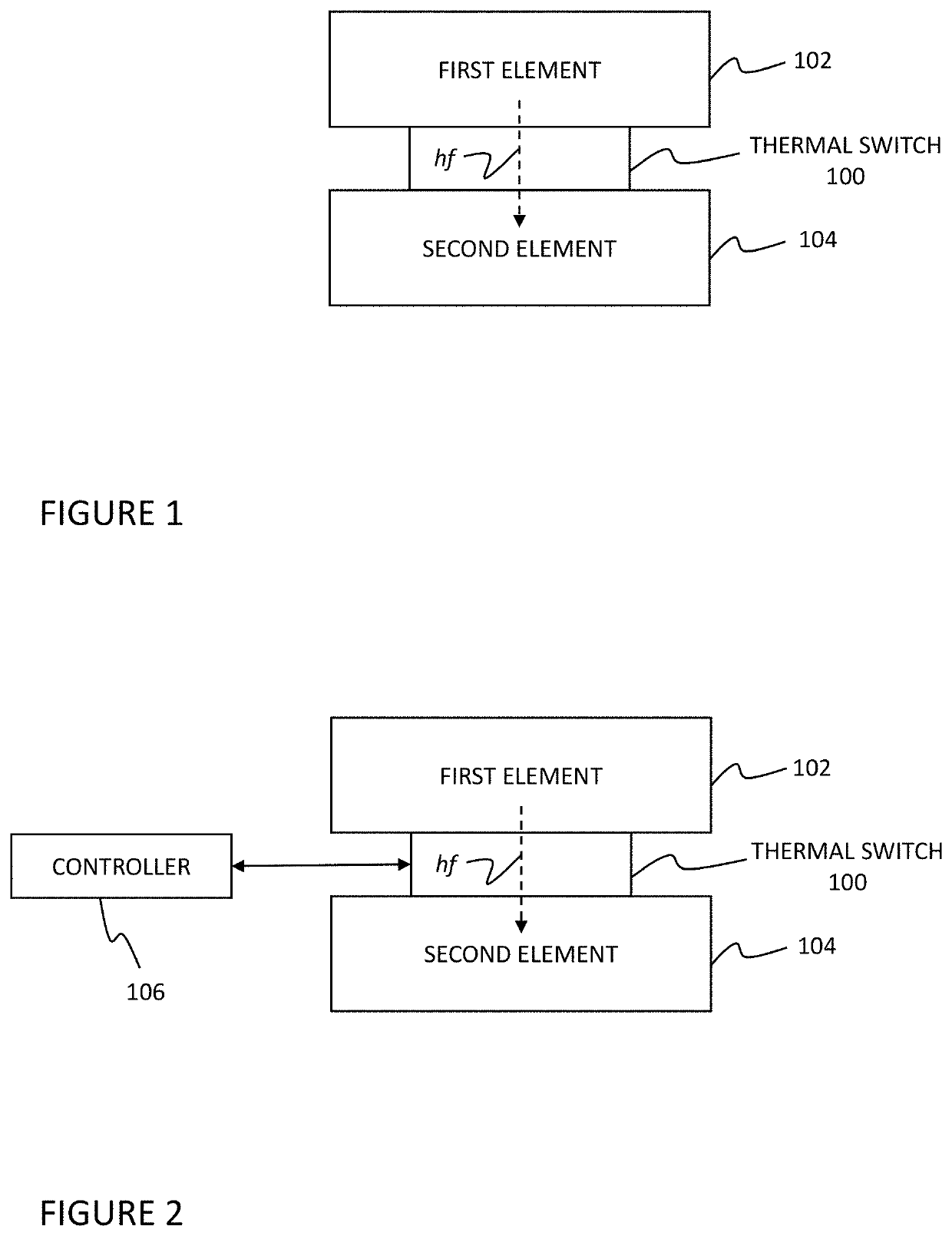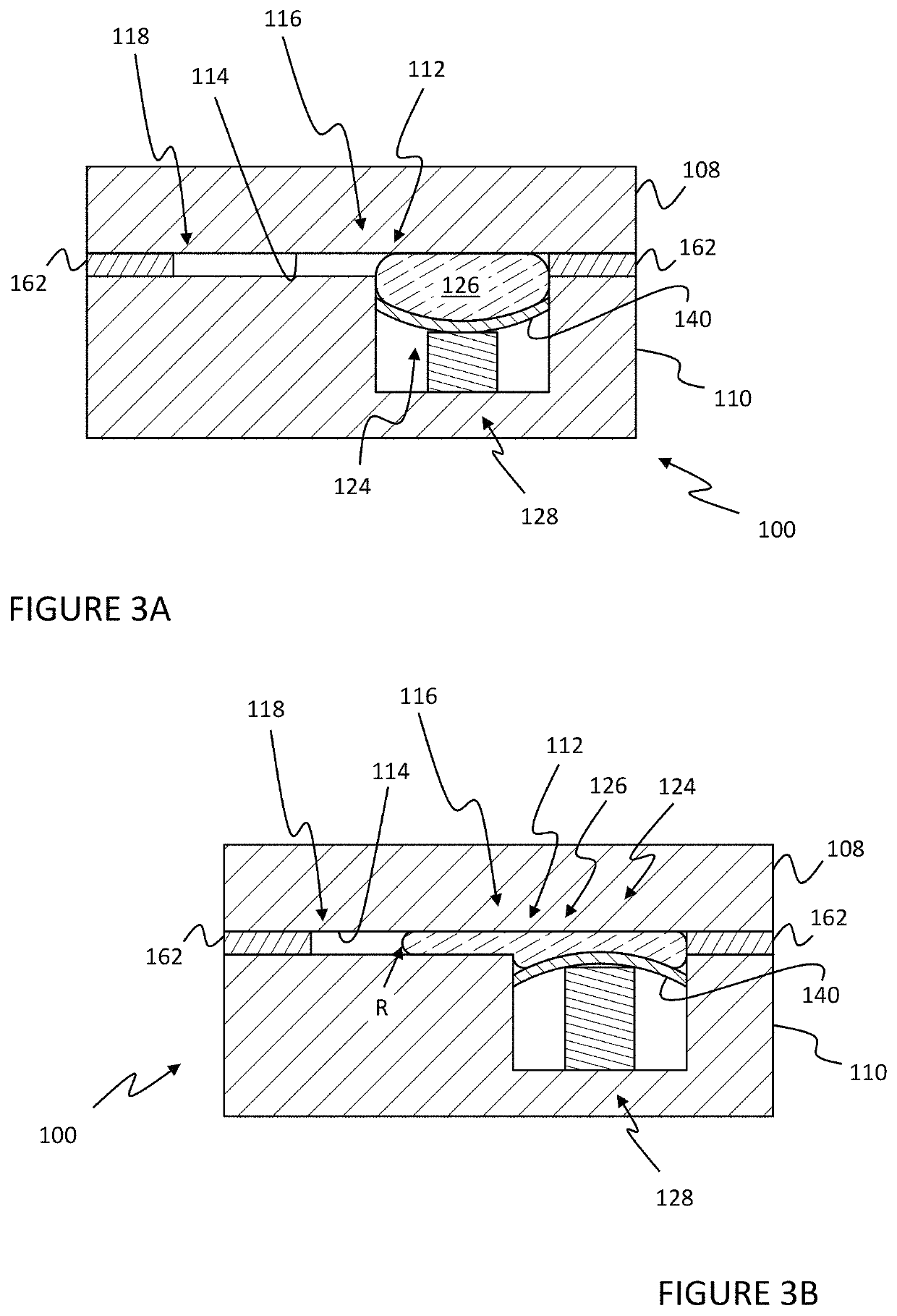Thermal switch
a switch and thermal technology, applied in the field of thermal switches, can solve the problems of difficult limitation of efficiency, maximum heat load, rate of temperature change, etc., and achieve the effects of improving efficiency and performance, precise, rapid, and proportional control of thermal conduction
- Summary
- Abstract
- Description
- Claims
- Application Information
AI Technical Summary
Benefits of technology
Problems solved by technology
Method used
Image
Examples
first embodiment
[0485]With reference to FIGS. 3A-3J, a thermal switch 100 according to a first embodiment is shown. In the illustrated embodiment, the thermal switch 100 includes a first plate 108, a second plate 110, a first reservoir 124, and an actuator 128. The actuator 128 may be an active actuator or a passive actuator. In general, an active actuator changes state in response to a control signal. Examples of active actuators include, but are not limited to, electric solenoids, pneumatic actuators, electric motors, piezoelectric actuators, MEMs actuators, electrostatic actuators and the like. In general, passive actuators change state based on an intrinsic thermal response of the actuator. Examples of passive actuators include, but are not limited to, actuators based on thermal expansion such as fluid in a piston or bellows, bimetallic elements, shape memory alloys and phase changing materials (such as melting wax in a piston). Passive actuators will generally have a fixed response (set at the...
second embodiment
[0517]With reference to FIGS. 4A-4J, a thermal switch 100 according to a second embodiment is shown. For purposes of discussion, the same reference numbers are used to refer to elements of the second embodiment of the thermal switch 100 as using in the first embodiment, where appropriate or otherwise noted.
[0518]In the illustrated embodiment, the thermal switch 100 of the second embodiment includes a first plate 108, a second plate 110, a first reservoir 124, and an actuator 128. The first plate 108 is composed from a thermally conductive material and forms a first side 148 of the thermal switch 100. For example, the first plate 108 may include a plurality of threaded apertures (not shown) and the first element 102 may be bolted or otherwise fastened to the first plate 108. It should be noted that the first element 102 may be otherwise thermally coupled to the first plate 108 including but not limited to via a thermally conductive interface or material, for example, thermal grease o...
third embodiment
[0538]With reference to FIGS. 5A-5B, a thermal switch 100 according to a third embodiment is shown. For purposes of discussion, the same reference numbers are used to refer to elements of the third embodiment of the thermal switch 100 as used in the first and second embodiments, where appropriate or otherwise noted.
[0539]Generally, the thermal switch 100 in the third embodiment is similar to the thermal switch 100 of the second embodiment, however, the actuator 128 and first reservoir 124 are located within the center of the thermal switch 100.
[0540]In the illustrated embodiment, the thermal switch 100 of the third embodiment includes a first plate 108, a second plate 110, a first reservoir 124, and an actuator 128. The first plate 108 is composed from a thermally conductive material and forms a first side 148 of the thermal switch 100.
[0541]The second plate 110 is composed from a thermally conductive material and forms a second side 150 of the thermal switch 100. In the illustrated...
PUM
 Login to View More
Login to View More Abstract
Description
Claims
Application Information
 Login to View More
Login to View More - R&D
- Intellectual Property
- Life Sciences
- Materials
- Tech Scout
- Unparalleled Data Quality
- Higher Quality Content
- 60% Fewer Hallucinations
Browse by: Latest US Patents, China's latest patents, Technical Efficacy Thesaurus, Application Domain, Technology Topic, Popular Technical Reports.
© 2025 PatSnap. All rights reserved.Legal|Privacy policy|Modern Slavery Act Transparency Statement|Sitemap|About US| Contact US: help@patsnap.com



